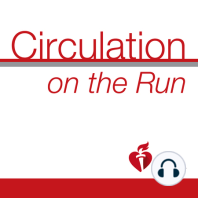18 min listen
Circulation August 15, 2017 Issue
ratings:
Length:
19 minutes
Released:
Aug 14, 2017
Format:
Podcast episode
Description
Dr. Carolyn Lam: Welcome to Circulation on the Run, your weekly podcast summary and backstage pass to the journal and its editors. I'm Dr. Carolyn Lam, associate editor from the National Heart Center and Duke National University of Singapore. Our podcast today highlights an important perspective piece on charting a future together and turning discovery science into cardiovascular health. You don't want to miss this, coming up right after these summaries. The first original paper tells us about the importance of changes in exercise capacity following transcatheter aortic valve replacement or TAVR. First author, Dr. Altisent, corresponding author, Dr. Rodés-Cabau, and colleagues from Quebec Heart and Lung Institute in Canada studied a total of 305 patients undergoing TAVR with baseline and six month followup exercise capacity assessments by six minute walk tests. They found that close to one-third of patients undergoing TAVR failed to improve their exercise capacity despite an optimal hemodynamic result post-procedure. Factors associated with a lesser exercise capacity improvement included patient characteristics such as older age, female sex, non-cardiac comorbidities, such as chronic obstructive lung disease, peripheral artery disease and bleeding episodes resulting in reduced hemoglobin levels. Importantly, the absence of an improvement in physical performance at six months post-TAVR was an independent predictor of mortality and adverse cardiovascular outcomes during the ensuing four years and particularly among patients with a greater impairment of exercise capacity pre-TAVR. Thus, implementing exercise capacity assessment pre and post-TAVR may help to improve patient risk stratification and augment the accuracy of the prognostic information given to patients, helping to identify those requiring more intensive followup assessment. The next study provides mechanistic insights into the adverse health outcomes associated with particulate matter exposure in the air. First author, Dr. Lee, corresponding author, Dr. Kahn, from Fudan University in Shanghai, China and colleagues conducted a randomized double-blind crossover trial in 55 healthy college students in Shanghai. Real and sham air purifiers were placed in participant's dormitories in random orders for nine days with a 12 day washout period. Serum metabolites were quantified using gas chromatography mass spec and ultra-high performance liquid chromatography mass spec. They found that higher particulate matter exposure led to a significant increase in cortisol, cortisone, epinephrine and norepinephrine. Between treatment, differences were also observed for glucose, amino acids, fatty acids and lipids. They also found that higher blood pressure, hormones, insulin resistance and biomarkers of oxidative stress and inflammation were present among individuals with higher exposure to particulate matter. Thus, this study showed that activation of the hypothalamus-pituitary-adrenal and sympathetic-adrenal medullary axis may contribute to the adverse cardiovascular and metabolic effects of particulate matter exposure in the air. In China, indoor air purification may be a practical way to reduce personal exposure to particulate matter. The next study shows that N-acetylcysteine may be new effective thrombolytic treatment. First author, Dr. Lizarrondo, corresponding author, Dr. Gauberti and colleagues from Inserm, France hypothesized that N-acetylcysteine might cleave the von Willebrand factor multimers inside occlusive thrombi, thereby leading to their disillusion and arterial recanalization. To test this hypothesis, the authors used experimental models of thrombotic stroke induced
Released:
Aug 14, 2017
Format:
Podcast episode
Titles in the series (100)
Circulation January 23, 2018 Issue by Circulation on the Run
